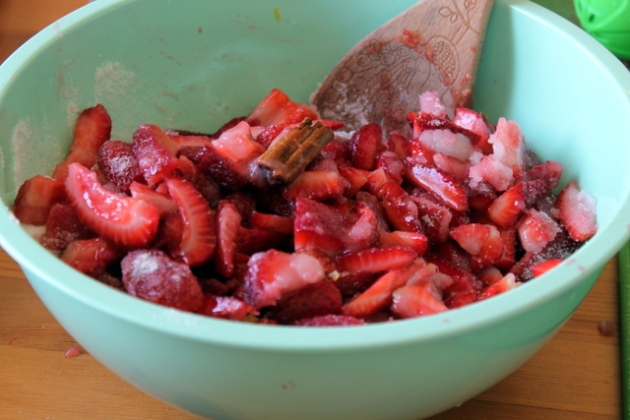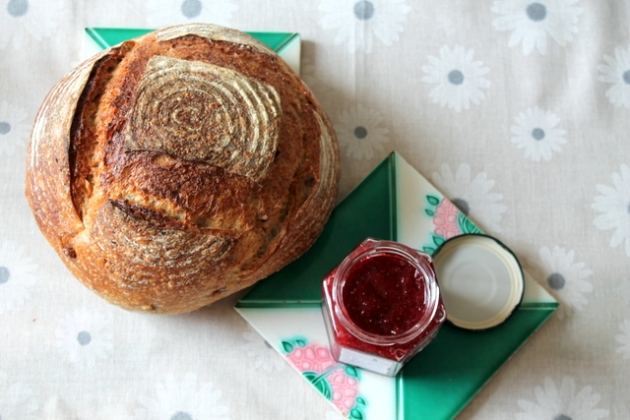Experimenting with "Saving the Season": Fancy Strawberry Jam with Pinot Noir
I always feel like there’s magic in the air in the springtime. The blooming flowers, the appearance of colorful fruits and vegetables at the market and the chirping birds all represent an awakening of the senses (also, hello, allergies!) and of the earth. Because this is an enchanted time, I often forget how fleeting it can be be. In part, this is because I wish it would last forever. This, however, is clearly wishful thinking. As we all know, the asparagus appears only to become scarce again and the strawberries, which though they appear in grocery stores for most of the year in California, seem to be fragrant and perfectly sweet for only a short window. I suppose this is what makes us appreciate the seasons; would these things be as delightful if we had access to them all year round?

In a way, no (this is why I always say no to hothouse tomatoes; they are forever disappointing. Tomatoes should taste of sunshine and summer; anything less is but a pale imitation), but, when it comes to preserving fruits and vegetables, the answer is yes. I think this is because there is a lot of work and love that goes into canning. From the excitement of picking out the fruit or vegetable to the process of transformation through heat, you’re taking the time to capture the season. There’s always a moment in winter when you long for sweet summer berries and there’s a moment in the heat of summer when all you want is the crisp chill of fall, apples and warming spices.

In recent years, I’ve gone a little crazy for preserving. While I don’t get to do it as often or in batches as large as I would like, I feel like there’s something to be said for even small-batch preserving: the stray jar that might make breakfast a little more special or help to transform dinner into a truly flavorful affair (this is why I keep a jar of preserved lemons around; it’s a meal saver if there ever was one). Two books that I often consult are Diana Henry’s Salt Sugar Smoke, a beautiful book if there ever was one, and Kevin West’s recent classic, Saving the Season, which is about so much more than preserving. West explores preserving through art, literature and essays; he also compares different methods (French vs. American vs. British) and presents a lot of different viewpoints about home canning. When reading his book, you can’t help but think that he’s a food anthropologist, traveling far and wide to collect stories and recipes. Although it’s a fairly recent addition to my collection, it’s a book I’ve been turning to more and more, especially this spring.
A few weeks ago, West’s recipe for Strawberry Preserves with Elderflower Liqueur jumped out at me; it seemed like it would have both texture (because the strawberries would be preserved only, they would be whole–really, more poached than cooked down) and a fragrant, floral quality that would evoke spring. There was one problem, though: I didn’t have any St. Germain and, given the amount of liqueur in our cabinet, it didn’t seem right to buy another bottle without first getting rid of something else. While I had a wonderful basil liqueur a friend had given me last year that might have worked, I immediately turned to something lighter and less herbal, namely the bottle of citrusy Lillet Blanc in the fridge. Then, I invited a friend over for a Saturday jamming session and promptly turned my attention to something else.

Two things happened afterward: 1) the night before, when my boyfriend and I were supposed to go and pick up some nice strawberries at Jack’s Night Market in Oakland (as well as meet with a preserves maker for another product review and interview), our little beagle collapsed from dehydration and we instead spent the night at the doggie emergency room, and 2) when I finally took another, more sustained look at the recipe, I realized that it wasn’t the kind of thing that involved much work. In fact, the fruit had to be macerated for 24 hours so that there would be enough juice to create an adequate preserving liquid. Since that wasn’t likely to happen in such a short period of time, the morning of our jam-making afternoon, I quickly decided on a new plan: Fancy Strawberry Jam with Pinot Noir, which West created in honor of the vanilla and strawberry jam of his friend Valerie Gordon, the LA-based sweet maker and owner of Valerie Confections.
I don’t know that I’m always the kind of person who easily rolls with the punches–I can be spontaneous, but I like having a set plan and sticking to it–but if this experience taught me anything, it’s that 1) I should always read the recipe well in advance and 2) kitchen accidents–veering from the plan because of a method or a missing ingredient-can be incredibly rewarding. This jam, which calls for only a few segments from a star anise pod and a 1-inch piece of cinnamon stick, is proof. It’s subtly spiced and fragrant, although the flavor of the Pinot Noir is barely there (I’m sure it adds depth, but my palate isn’t fine enough to pick out individual flavors). However, when you lick the leftover jam off a spoon or a knife, the flavor of strawberries overwhelms you, followed by the tiniest–and most welcome–hint of licorice. It’s fancy alright, fancy enough to make mere toast seem like the breakfast of a queen (or a king) and a good reason to follow West’s advice and recipes and to “save the season” at home.
If you’re looking for more strawberry inspiration, here’s a recipe for an avocado salad that might also have some appeal.

Fancy Strawberry Jam with Pinot Noir
from Kevin West’s Saving the Season
yields 4 (1-pint) jars
3 pounds ripe strawberries
2 1/2 cups granulated sugar
2 tablespoons fresh lemon juice
zest of 1/4 lemon (about 1/4-1/2 teaspoons)
1-inch piece of a cinnamon stick
2-3 segments of a star anise pod
3 tablespoons Pinot Noir
-Rinse the strawberries and drain them. Then, remove the tops and quarter the strawberries lengthwise. Ideally, your strawberries will be small, but, if not, halve each quarter.
-Place the berries in a large bowl, then add the sugar, lemon juice and zest and spices. Leave to macerate for 30-45 minutes.
-In the meantime, prepare the jars. Preheat the oven to 250 and line a baking sheet with parchment. Wash the jars in warm, soapy water and then place on the baking sheet. Leave in the oven until the jam is ready (you want the jars to be hot when the jam is done).
-Pour the strawberries and their liquid into a large pot or preserving pan (I use a large Dutch oven) and bring to a boil over high heat.
-Using a whisk, stir constantly and vigorously, which will help to break the berries down into a paste.
-Add the Pinot Noir after 6-8 minutes and keep whisking.
-Continue reducing to the gel point (this is when the jam is ready to jar. You will know when the jam coats the back of a cold spoon, when the temperature is 220 F, or by a few quick and reliable methods. You can either chill a saucer, put a teaspoon of hot jam on it and place it in the freezer and, if it wrinkles when you push it, it is ready, OR you can put a dab of jam between your fingertips and, when you stretch them out, look to see if the jam forms a thin thread. While checking through any of these methods, it is best to reduce the heat to very low or to remove the pot from the heat so that the jam will not burn). West says that, after you’ve added the Pinot Noir, this should take only another 4-6 minutes; because we weren’t using a copper jam pot, however, it took a solid 25-30 minutes before our jam was ready.
-Once the jam is set, whisk for another minute or two until the jam is smooth and then carefully remove the spices (cheesecloth or a metal tea strainer can be useful here).
-Ladle the jam into 4 prepared 1/2 pint jars (if the jars are too hot, the jam will sizzle. If this happens, wait a few minutes and then try again), leaving about 1/4-inch headspace. Wipe off the rims of the jars with a warm towel (any sticky jam remnants will prevent proper sealing) and place the lid on them. Then, screw on the rings.
-Process the jars in the oven at 250 F for 15 minutes, then set on a rack until they cool completely and seal. If one of the jars doesn’t seal, don’t worry: you can either reheat the contents and re-sterilize the jars or put the jar in the fridge for immediate consumption.
Comments (0)
0